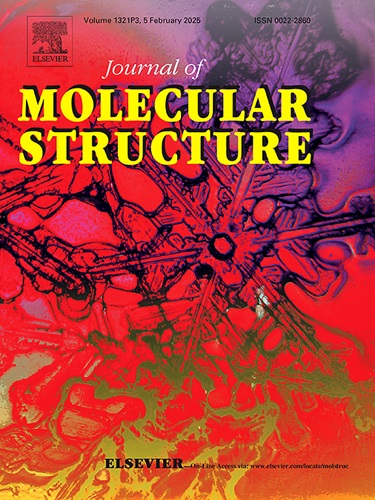N, N'-双(吡啶基甲基)草酰胺与聚羧酸异构体构建的配位聚合物:金属和配体对结构多样性的影响
IF 4
2区 化学
Q2 CHEMISTRY, PHYSICAL
引用次数: 0
摘要
反应的N, N ' bis (3-pyridylmethyl) oxalamide (L1)或N, N ' bis (4-pyridylmethyl) oxalamide (L2)多羧酸的酸和二价金属盐提供八个协调聚合物,{[Cd (L1)(1、3、5-HBTC) (H2O)]·3 H2O} N(1、3、5-H3BTC = benzene-1 3 5-tricarboxylic酸),1,{[Cd(1、3、5-BTC) (H2O)) * (H2L2) 0.5 * 3 H2O} N, 2,{[二氧化碳(L2) (SDA) 2(µ这里)(H2O) 2] 6·H2O} N (H2SDA = 4, 4’-sulfonyldibenzoic酸)3{[锌(L2) 0.5(1、2、4,5-BTEC) 0.5 (H2O)]⋅2水}N(1、2、4,5-H4BETC = 1, 2, 4, 5-benzenetetracarboxylic酸),4,{[Ni(L2)(5- nipa)(H2O)]⋅H2O}n (5- h2nipa = 5-硝基间苯二甲酸),5,{[Ni(L1)(5- nipa)(H2O)]⋅H2O}n, 6, {[Ni(L1)0.5(TBIP)(H2O)2]⋅H2O}n (H2TBIP = 5-丁基间苯二甲酸),7,和{[Ni(L2)1.5(TBIP)(H2O)]⋅4H2O}n, 8,通过单晶x射线衍射对其进行了结构表征。配合物1 - 4形成具有2,2,4c1拓扑结构的1D链、具有sra拓扑结构的3D框架、具有dia拓扑结构的2倍互穿3D框架和具有bex拓扑结构的2D网状结构,而5 - 8分别形成具有3,5l2、2,4l3、3倍互穿(103)(10)和hcb拓扑结构的2D网状结构,揭示了金属和配体异构对结构多样性的影响。并评价了配合物1、2和4的发光性能和配合物3的碘吸附性能。脱溶配合物3在脱水和吸附过程中表现出可逆的结构转变。本文章由计算机程序翻译,如有差异,请以英文原文为准。

Coordination polymers constructed from isomeric N‚N'-bis(pyridylmethyl)oxalamide and polycarboxylic acids: Metal and ligand effect on the structural diversity
Reactions of N‚N'-bis(3-pyridylmethyl)oxalamide (L1) or N‚N'-bis(4-pyridylmethyl)oxalamide (L2) with polycarboxylic acid and divalent metal salt afforded eight coordination polymers, {[Cd(L1)(1,3,5-HBTC)(H2O)]·3H2O}n (1,3,5-H3BTC = benzene-1,3,5-tricarboxylic acid), 1, {[Cd(1,3,5-BTC)(H2O)]·(H2L2)0.5·3H2O}n, 2, {[Co2(L2)(SDA)2 (µ-OH2)(H2O)2]·6H2O}n (H2SDA = 4,4′-sulfonyldibenzoic acid), 3, {[Zn(L2)0.5(1,2,4,5-BTEC)0.5(H2O)]⋅2H2O}n (1,2,4,5-H4BETC = 1,2,4,5-benzenetetracarboxylic acid), 4, {[Ni(L2)(5-NIPA)(H2O)]⋅H2O}n (5-H2NIPA = 5-nitroisophthalic acid), 5, {[Ni(L1)(5-NIPA)(H2O)]⋅H2O}n, 6, {[Ni(L1)0.5(TBIP)(H2O)2]⋅H2O}n (H2TBIP = 5‑tert-butylisophthalic acid), 7, and {[Ni(L2)1.5(TBIP)(H2O)]⋅4H2O}n, 8, which have been structurally characterized by using single crystal X-ray diffraction. Complexes 1 – 4 form a 1D chain with the 2,2,4C1 topology, a 3D framework with the sra topology, a 2-fold interpenetrated 3D framework with the dia topology and a 2D net with the bex topology, whereas 5 – 8 are 2D nets with 3,5L2, 2,4L3, 3-fold interpenetrated (103)(10) and hcb topologies, respectively, revealing the metal and ligand-isomerism effect on the structural diversity. Luminescent properties of complexes 1, 2 and 4 and iodine adsorption of 3 are also evaluated. Reversible structural transformation upon water removal and adsorption can be shown for the desolvated complex 3.
求助全文
通过发布文献求助,成功后即可免费获取论文全文。
去求助
来源期刊

Journal of Molecular Structure
化学-物理化学
CiteScore
7.10
自引率
15.80%
发文量
2384
审稿时长
45 days
期刊介绍:
The Journal of Molecular Structure is dedicated to the publication of full-length articles and review papers, providing important new structural information on all types of chemical species including:
• Stable and unstable molecules in all types of environments (vapour, molecular beam, liquid, solution, liquid crystal, solid state, matrix-isolated, surface-absorbed etc.)
• Chemical intermediates
• Molecules in excited states
• Biological molecules
• Polymers.
The methods used may include any combination of spectroscopic and non-spectroscopic techniques, for example:
• Infrared spectroscopy (mid, far, near)
• Raman spectroscopy and non-linear Raman methods (CARS, etc.)
• Electronic absorption spectroscopy
• Optical rotatory dispersion and circular dichroism
• Fluorescence and phosphorescence techniques
• Electron spectroscopies (PES, XPS), EXAFS, etc.
• Microwave spectroscopy
• Electron diffraction
• NMR and ESR spectroscopies
• Mössbauer spectroscopy
• X-ray crystallography
• Charge Density Analyses
• Computational Studies (supplementing experimental methods)
We encourage publications combining theoretical and experimental approaches. The structural insights gained by the studies should be correlated with the properties, activity and/ or reactivity of the molecule under investigation and the relevance of this molecule and its implications should be discussed.
 求助内容:
求助内容: 应助结果提醒方式:
应助结果提醒方式:


